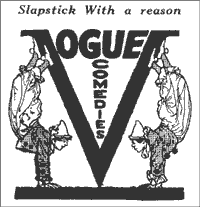Vogue Films, Inc. (1915-1917)
By
Robert S. Birchard
 Vogue Films,
Inc. was organized in October, 1915 as a separate production company affiliated
with the American Film Company of Chicago and Santa Barbara to produce comedies
for the Mutual Film Corporation program. American's president, S. S. Hutchinson,
served as chairman of the corporation, and the president of Vogue was Joseph
Finn. Vogue's studio manager was J. R. Crone.
Vogue Films,
Inc. was organized in October, 1915 as a separate production company affiliated
with the American Film Company of Chicago and Santa Barbara to produce comedies
for the Mutual Film Corporation program. American's president, S. S. Hutchinson,
served as chairman of the corporation, and the president of Vogue was Joseph
Finn. Vogue's studio manager was J. R. Crone.
 The first Vogue
films were produced at the Signal Film Company studio located at 4560 Pasadena
Avenue (now Figueroa Street) in the Highland Park district of Los Angeles (Signal
was another affiliate of American), but the company soon moved to its own lot
on Santa Monica Boulevard at Gower Street in Hollywood. Initially, the Vogue
pictures were slated to be single-reelers released at the rate of two pictures
a week, but "Sammy's Scandalous Schemes," the first Vogue comedy,
was released on December 27, 1915 in two reels and all subsequent Vogue pictures
were produced as two-reelers. British comic Sammy Burns was the first Vogue
star. Burns was a blatant imitator of Charlie Chaplin, and his services were
no longer attractive after the Mutual Film Corporation signed Chaplin on February
25, 1916.
The first Vogue
films were produced at the Signal Film Company studio located at 4560 Pasadena
Avenue (now Figueroa Street) in the Highland Park district of Los Angeles (Signal
was another affiliate of American), but the company soon moved to its own lot
on Santa Monica Boulevard at Gower Street in Hollywood. Initially, the Vogue
pictures were slated to be single-reelers released at the rate of two pictures
a week, but "Sammy's Scandalous Schemes," the first Vogue comedy,
was released on December 27, 1915 in two reels and all subsequent Vogue pictures
were produced as two-reelers. British comic Sammy Burns was the first Vogue
star. Burns was a blatant imitator of Charlie Chaplin, and his services were
no longer attractive after the Mutual Film Corporation signed Chaplin on February
25, 1916.
Through most of its short history, Vogue had two units working. Company #1
was headed by comedian/director Rube Miller and featured Owen Evans, Ward McAllister,
and Lillian Hamilton in support. Henry Kernan directed Company # 2, which featured
Charlie Chaplin's former Essanay Film Mfg. Co. associate, Ben Turpin. Appearing
with the second company were Paddy McGuire (sometimes spelled McQuire), another
Chaplin/Essanay alumnus, Gipsey Abbott, and Arthur Moon. Also seen in Vogue
comedies were future director John Francis Dillon and soon-to-be dramatic star
Priscilla Dean. The Vogue releases were designed to compete in the marketplace
with the rival Triangle-Keystone comedies and Universal's L-Ko comedies. Vogue
Films, Inc. remained in operation about a year and a half, and released films
into mid-1917.
Above images are: The Vogue Films Logo (top image). (bottom image) Comic-actor
Ben Turpin.
 Vogue Films,
Inc. was organized in October, 1915 as a separate production company affiliated
with the American Film Company of Chicago and Santa Barbara to produce comedies
for the Mutual Film Corporation program. American's president, S. S. Hutchinson,
served as chairman of the corporation, and the president of Vogue was Joseph
Finn. Vogue's studio manager was J. R. Crone.
Vogue Films,
Inc. was organized in October, 1915 as a separate production company affiliated
with the American Film Company of Chicago and Santa Barbara to produce comedies
for the Mutual Film Corporation program. American's president, S. S. Hutchinson,
served as chairman of the corporation, and the president of Vogue was Joseph
Finn. Vogue's studio manager was J. R. Crone.  The first Vogue
films were produced at the Signal Film Company studio located at 4560 Pasadena
Avenue (now Figueroa Street) in the Highland Park district of Los Angeles (Signal
was another affiliate of American), but the company soon moved to its own lot
on Santa Monica Boulevard at Gower Street in Hollywood. Initially, the Vogue
pictures were slated to be single-reelers released at the rate of two pictures
a week, but "Sammy's Scandalous Schemes," the first Vogue comedy,
was released on December 27, 1915 in two reels and all subsequent Vogue pictures
were produced as two-reelers. British comic Sammy Burns was the first Vogue
star. Burns was a blatant imitator of Charlie Chaplin, and his services were
no longer attractive after the Mutual Film Corporation signed Chaplin on February
25, 1916.
The first Vogue
films were produced at the Signal Film Company studio located at 4560 Pasadena
Avenue (now Figueroa Street) in the Highland Park district of Los Angeles (Signal
was another affiliate of American), but the company soon moved to its own lot
on Santa Monica Boulevard at Gower Street in Hollywood. Initially, the Vogue
pictures were slated to be single-reelers released at the rate of two pictures
a week, but "Sammy's Scandalous Schemes," the first Vogue comedy,
was released on December 27, 1915 in two reels and all subsequent Vogue pictures
were produced as two-reelers. British comic Sammy Burns was the first Vogue
star. Burns was a blatant imitator of Charlie Chaplin, and his services were
no longer attractive after the Mutual Film Corporation signed Chaplin on February
25, 1916.